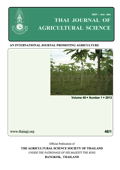Phenylalanine Ammonia Lyase Activity of Soybean’s Seedlings Introduced with Rhizobacteria, which had Ability to Induce Resistance of Soybeans Towards Bacterial Pustule (Xanthomonas axonopodis pv. glycines)
Main Article Content
Abstract
Xanthomonas axonopodis pv. glycines is a major constraint in soybean cultivation and cause bacterial pustule disease. One of mechanism of ISR on plant are changes of phenylalanine lyase enzymes activity. Four rhizobacterial isolates, which have ability to induce systemic resistance (ISR) of soybean were tested its ability to induce Phenylalanine ammonia lyase (PAL) activity. The aim of this experiment was to study the activity of PAL in rhizobacteria introduced soybean which have ISR against Xanthomonas axonopodis pv. glycines. The experiment has been done in triplicate. Four rhizobacteria isolates were introduced on soybean seed and two weeks old seedling. PAL activity was assayed on soybean seedlings gradually (0, 2, 4, 8, 10, 12, 14, 16, 18, 20, 22, 24, 30 and 35 days after rhizobacterial introduction). Study showed that all rhizobacteria introduced to soybean’s seedlings have ability to increase activity of PAL enzyme compared to control.


